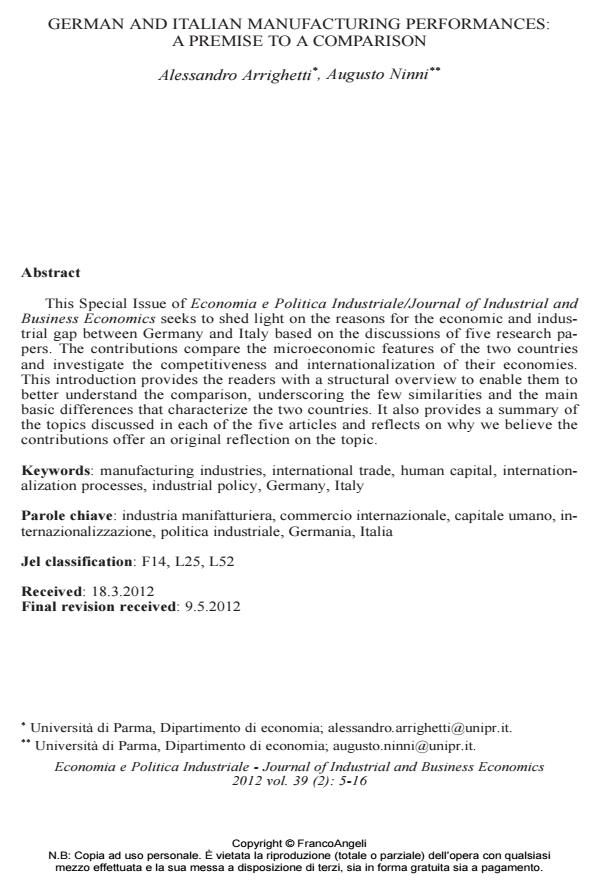German and Italian manufacturing performances: a premise to a comparison
Journal title ECONOMIA E POLITICA INDUSTRIALE
Author/s Alessandro Arrighetti, Augusto Ninni
Publishing Year 2012 Issue 2012/2
Language English Pages 12 P. 5-16 File size 103 KB
DOI 10.3280/POLI2012-002001
DOI is like a bar code for intellectual property: to have more infomation
click here
Below, you can see the article first page
If you want to buy this article in PDF format, you can do it, following the instructions to buy download credits

FrancoAngeli is member of Publishers International Linking Association, Inc (PILA), a not-for-profit association which run the CrossRef service enabling links to and from online scholarly content.
This Special Issue of Economia e Politica Industriale/Journal of Industrial and Business Economics seeks to shed light on the reasons for the economic and industrial gap between Germany and Italy based on the discussions of five research papers. The contributions compare the microeconomic features of the two countries and investigate the competitiveness and internationalization of their economies. This introduction provides the readers with a structural overview to enable them to better understand the comparison, underscoring the few similarities and the main basic differences that characterize the two countries. It also provides a summary of the topics discussed in each of the five articles and reflects on why we believe the contributions offer an original reflection on the topic.
Keywords: Manufacturing industries, international trade, human capital, internationalization processes, industrial policy, Germany, Italy
Jel codes: F14, L25, L52
- Value chains and the great recession: Evidence from Italian and German firms Antonio Accetturo, Anna Giunta, in International Economics /2018 pp.55
DOI: 10.1016/j.inteco.2017.07.002 - The financing methods for small and medium companies: comparison between Italy and Germany Matteo Rossi, Elisa Giacosa, Alberto Mazzoleni, in Corporate Ownership and Control /2016 pp.366
DOI: 10.22495/cocv13i3c2p9 - Assessing the Competitiveness of Serbian Textile and Apparel Industry Exports Using RCA Index and TPI Indicators Enes Corovic, Iva Jestratijevic, in Fibres and Textiles in Eastern Europe /2021 pp.15
DOI: 10.5604/01.3001.0014.8226 - Modeling hard and soft facts for SMEs: Some international evidence Massimo Matthias, Michele Giammarino, Giampaolo Gabbi, in Journal of International Financial Management & Accounting /2019 pp.203
DOI: 10.1111/jifm.12108 - Value Chains and the Great Recession: Evidence from Italian and German Firms Antonio Accetturo, Anna Giunta, in SSRN Electronic Journal /2016
DOI: 10.2139/ssrn.2759835 - Barriers and drivers for the adoption of industrial sustainability measures in European SMEs: Empirical evidence from chemical and metalworking sectors Alessandra Neri, Enrico Cagno, Andrea Trianni, in Sustainable Production and Consumption /2021 pp.1433
DOI: 10.1016/j.spc.2021.08.018 - Competitiveness of the Textile Industry of the Republic of Serbia on the EU Market Živorad Gligorijević, Enes Ćorović, in Economic Themes /2020 pp.1
DOI: 10.2478/ethemes-2020-0001
Alessandro Arrighetti, Augusto Ninni, German and Italian manufacturing performances: a premise to a comparison in "ECONOMIA E POLITICA INDUSTRIALE " 2/2012, pp 5-16, DOI: 10.3280/POLI2012-002001